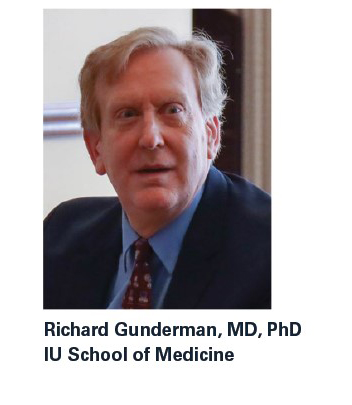By: Richard Gunderman, MD, PhD
IU School of Medicine

Bullying has long been a problem throughout the American workplace, but as an increasing percentage of U.S. physicians have transitioned from practice ownership to employment by non-physician-owned medical practices, hospitals and health systems, their exposure to such abuse has increased apace. Looking at the problem medically, it is important to understand what bullying is, how to recognize it and how important it is to prevent or remedy it when it occurs.
Studies have estimated that about 30% of the U.S. workforce is or has been bullied at work, and in about 75% of cases, bullies outrank their victims. One definition characterizes bullying as “persistent verbal and nonverbal aggression at work, including personal attacks, ostracism, painful messages and hostile interactions.” In general, victims are more likely to be women than men, and when the victim is a woman, the perpetrator is more likely to also be a woman.
One of the most widely publicized examples of a 21st-century American bully involves what was once the nation’s seventh-largest corporation, Enron, which went bankrupt in 2001. Named the nation’s most innovative company six years in a row, it turned out to have been cooking its books, and its collapse cost 20,000 employees their jobs. Arthur Andersen, once one of the largest and most respected U.S. accounting firms, went belly up along with its client, costing an additional 30,000 jobs.
At the center of this business debacle – at the time, the largest corporate bankruptcy in U.S. history – stood a bully, CEO Jeffrey Skilling. Widely known as a boor, Skilling, who graduated in the top 5% of his class at Harvard Business School, boasted that he was “f-ing smart” while dismissing those who disagreed with him as ignorant, incompetent, and in some cases, “a-holes.” Citing his favorite book, “The Selfish Gene,” Skilling sought to motivate employees by greed.
Skilling also established what he called “the most important program in the company,” the “Performance Review Committee,” in which the “bottom” 10-15% of employees would be fired every year, instituting a reign of fear. Of course, most bullies are not criminals, but Skilling also introduced new accounting rules that underwrote fraud, which he defended ruthlessly. If a banker, accountant, lawyer or analyst raised questions, Skilling reacted with humiliation, loss of future contracts, or termination.
In Skilling-speak, someone who wanted a clear explanation of Enron’s business practices would be ridiculed for failing to understand the company. Any critic of Skilling’s leadership would be rebuffed or intimidated. He made sure that people were pitted against one another and therefore would hesitate to share their real thoughts. Winners were those who did whatever it took to boost the bottom line, and everyone else was at best an also-ran, more likely a loser.
Skilling liked to say, “I am Enron.” Arrogance and intolerance were his modus operandi, and his narcissism often expressed itself in outbursts of rage against those who dared question his brilliance. Around the turn of the century, as Enron’s house of cards began to collapse, Skilling became even more hubristic and thin-skinned. Stories of his disdain for others abound, such as his habit of jumping the line of cars waiting to exit the company’s parking garage, shooting past others with his middle finger raised.
Several years after the company folded, the day of reckoning for Skilling and other leaders arrived. Indicted on 35 counts, he was found guilty of conspiracy, insider trading, making false statements and securities fraud, and was sentenced to 24 years in prison and a $45 million fine. To the end, Skilling was unrepentant, maintaining, “We are the good guys. We are on the side of the angels.” Yet, throughout his years at Enron, Skilling manifested a profound disregard for ethics.
The Skilling story is illuminating for contemporary physicians. For one, it displays the features of a bully writ large. Skilling evinced no regard for the dignity of other people, treating them as mere tools or stepping stones to his own success. His bloated but fragile ego rendered him hypersensitive to opposition of any kind, and he used anger and threats to silence others and keep them in line. He did everything he could to keep the black box of his own activities opaque.
Such bullying strategies are often referred to as, “Kiss up, kick down.” When things go well, all credit goes to the bully, but when anything goes wrong, blame gets directed to subordinates or uncontrollable circumstances. Everyone in a position to ask questions is kept in a constant state of fear. Information is not shared. Soon, everyone feels as though they are walking on eggshells. A general sense of bad faith prevails, where people cannot be themselves.
There is no one-size-fits-all solution to bullying, but several general principles are crucial. Physicians should do what they can to remain calm during confrontations, keep in mind the good things they are doing for the organization and the patients and community it serves, and reach out to human resources professionals on a confidential basis. Like Skilling, bullies may seem to be building the organization, but inevitably they sow seeds of toxic culture that take a great toll on good people.
Physicians should conceptualize bullying as an affliction that all health care organizations need help in eradicating. It can take a huge toll on health by inflicting stress and burnout, and it also harms the character of all involved, including those who merely witness it. In the short term, it can prove impossible to remove a bully, but from the long view, it is vital that physicians act as truth-tellers with strong moral compasses, who help to prevent malefactors from winning.
Richard Gunderman, MD, PhD, is the chair of the ISMA Wellness Steering Committee.